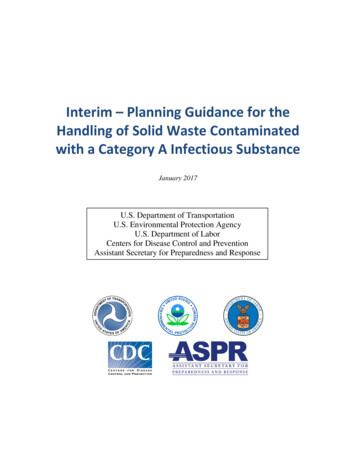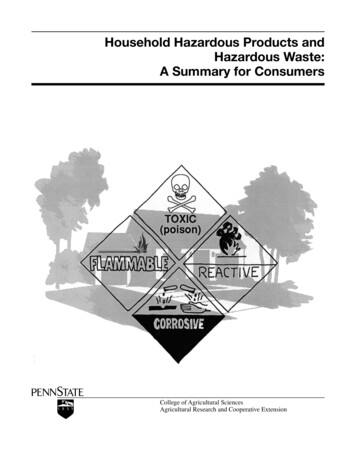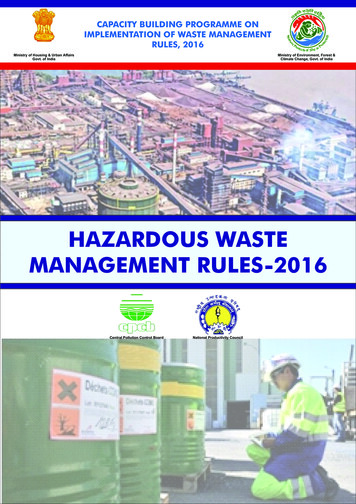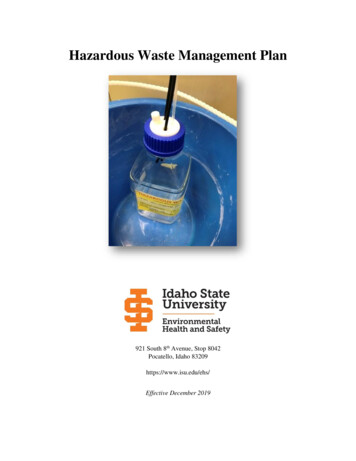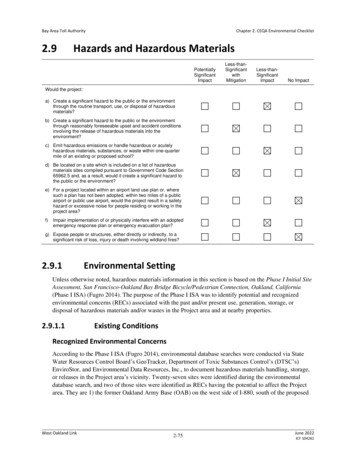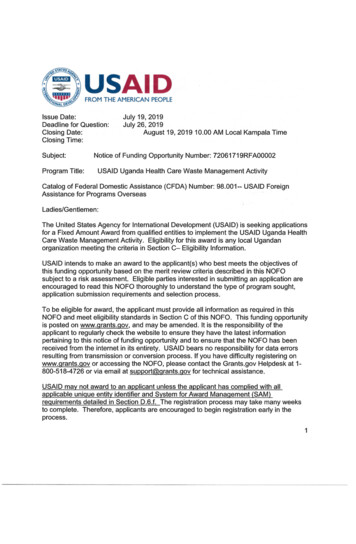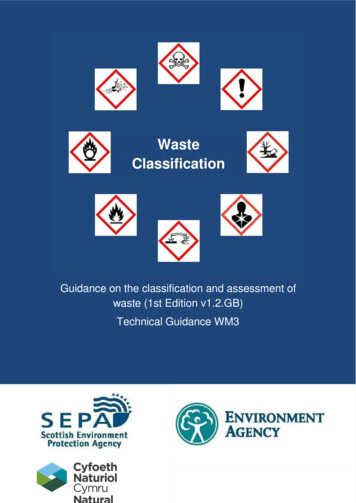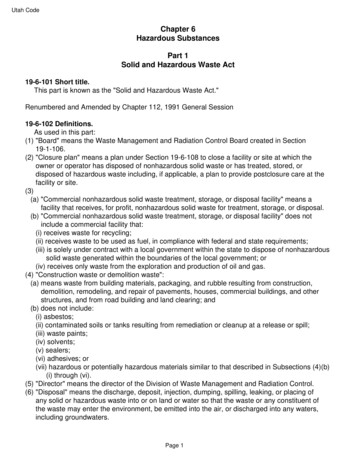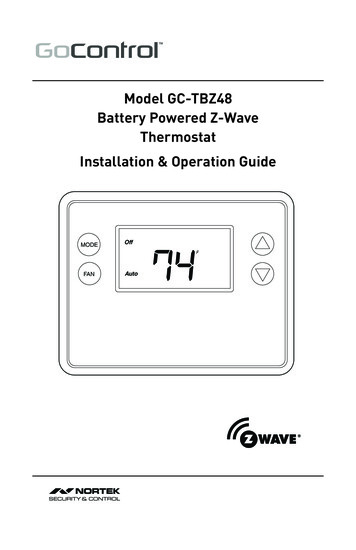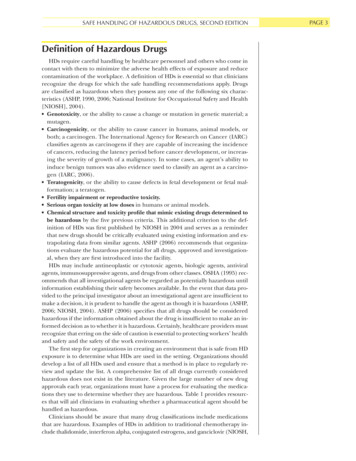
Transcription
SAFE HANDLING OF HAZARDOUS DRUGS, SECOND EDITIONDefinition of Hazardous DrugsHDs require careful handling by healthcare personnel and others who come incontact with them to minimize the adverse health effects of exposure and reducecontamination of the workplace. A definition of HDs is essential so that cliniciansrecognize the drugs for which the safe handling recommendations apply. Drugsare classified as hazardous when they possess any one of the following six characteristics (ASHP, 1990, 2006; National Institute for Occupational Safety and Health[NIOSH], 2004). Genotoxicity, or the ability to cause a change or mutation in genetic material; amutagen. Carcinogenicity, or the ability to cause cancer in humans, animal models, orboth; a carcinogen. The International Agency for Research on Cancer (IARC)classifies agents as carcinogens if they are capable of increasing the incidenceof cancers, reducing the latency period before cancer development, or increasing the severity of growth of a malignancy. In some cases, an agent’s ability toinduce benign tumors was also evidence used to classify an agent as a carcinogen (IARC, 2006). Teratogenicity, or the ability to cause defects in fetal development or fetal malformation; a teratogen. Fertility impairment or reproductive toxicity. Serious organ toxicity at low doses in humans or animal models. Chemical structure and toxicity profile that mimic existing drugs determined tobe hazardous by the five previous criteria. This additional criterion to the definition of HDs was first published by NIOSH in 2004 and serves as a reminderthat new drugs should be critically evaluated using existing information and extrapolating data from similar agents. ASHP (2006) recommends that organizations evaluate the hazardous potential for all drugs, approved and investigational, when they are first introduced into the facility.HDs may include antineoplastic or cytotoxic agents, biologic agents, antiviralagents, immunosuppressive agents, and drugs from other classes. OSHA (1995) recommends that all investigational agents be regarded as potentially hazardous untilinformation establishing their safety becomes available. In the event that data provided to the principal investigator about an investigational agent are insufficient tomake a decision, it is prudent to handle the agent as though it is hazardous (ASHP,2006; NIOSH, 2004). ASHP (2006) specifies that all drugs should be consideredhazardous if the information obtained about the drug is insufficient to make an informed decision as to whether it is hazardous. Certainly, healthcare providers mustrecognize that erring on the side of caution is essential to protecting workers’ healthand safety and the safety of the work environment.The first step for organizations in creating an environment that is safe from HDexposure is to determine what HDs are used in the setting. Organizations shoulddevelop a list of all HDs used and ensure that a method is in place to regularly review and update the list. A comprehensive list of all drugs currently consideredhazardous does not exist in the literature. Given the large number of new drugapprovals each year, organizations must have a process for evaluating the medications they use to determine whether they are hazardous. Table 1 provides resources that will aid clinicians in evaluating whether a pharmaceutical agent should behandled as hazardous.Clinicians should be aware that many drug classifications include medicationsthat are hazardous. Examples of HDs in addition to traditional chemotherapy include thalidomide, interferon alpha, conjugated estrogens, and ganciclovir (NIOSH,PAGE 3
PAGE 4SAFE HANDLING OF HAZARDOUS DRUGS, SECOND EDITIONTable 1. Resources for Developing a List of Hazardous DrugsResourceDescriptionAmerican Hospital Formulary Service (AHFS) Pharmacologic-Therapeutic Classification SystemThe AHFS Pharmacologic-Therapeutic Classification System is a widely accepted system forclassification of drugs into categories based on mechanism of action. The system designates allantineoplastic agents as category 10; all category 10 drugs are hazardous.IARC Monographs on the Evaluationof Carcinogenic Risks to HumansMonographs categorize the drugs, viruses, and other substances as Group 1: The agent is carcinogenic to humans. Group 2A: The agent is probably carcinogenic to humans. Group 2B: The agent is possibly carcinogenic to humans. Group 3: The agent is not classifiable as to its carcinogenicity to humans. Group 4: The agent is probably not carcinogenic to humans.Material safety data sheets (MSDS)MSDS are developed by manufacturers to describe the chemical properties of a product, including Health effects and first aid for exposure Storage, handling, and disposal information Personal protection Procedures for cleaning in the event of a spill.Manufacturers are required to provide MSDS for all drugs that are deemed hazardous or containhazardous components.National Toxicology Program’sReport on CarcinogensCarcinogens listed in this report are classified either as known human carcinogens or reasonably anticipated to be human carcinogens. The report can be obtained at http://ntp.niehs.nih.gov/go/roc.NIOSHAppendix A of Preventing Occupational Exposure to Antineoplastic and Other Hazardous Drugsin Health Care Settings contains a table with a sample list of drugs that should be handled ashazardous. The hazardous drug list was updated in 2010 and can be found at Package inserts for specific pharmaceutical agentsPackage inserts for all U.S. Food and Drug Administration–approved medications contain information to assist clinicians in determining whether a drug should be classified as hazardous, including Drug classification Pregnancy category and reproductive toxicity Organ toxicities Secondary cancers that may develop with exposure Drug warnings.Note. Based on information from American Society of Health-System Pharmacists, 2010; International Agency for Research on Cancer, 2006; National Institute for Occupational Safety and Health, 2004; U.S. Department of Health and Human Services, Public Health Service, National Toxicology Program, 2010.2004). Because HDs are administered in multiple clinical areas, it is imperative thatsafe handling training extend beyond the oncology unit. HD safe handling is an organizational issue.Adverse Effects of Hazardous Drug ExposureThe adverse effects of HDs in treated patients are well known and generally seenas outweighed by the benefits of treatment, and measures are implemented to prevent or minimize these hazardous effects. The adverse effects of occupational exposure to HDs in HCWs, on the other hand, have no associated benefit. Precautionsthat will prevent or minimize occupational exposure to HDs are recommended inthe literature. However, despite the existence of published research studies, guidelines, and recommendations, HCWs do not always follow measures to reduce HDexposure. This lack of action places HCWs at risk for myriad adverse effects. Adverseeffects of occupational HD exposure are listed by system in Table 2.
PAGE 5SAFE HANDLING OF HAZARDOUS DRUGS, SECOND EDITIONAdverse effects of HD exposure can be categorized aseither biologic or health effects. The consequences of HDexposure have been reported for more than 30 years. Although biologic effects have not always been linked tochanges in health at the time of the studies, those identified have been associated with adverse health outcomes.For example, chemotherapy-related malignancies (myelodysplastic syndrome and acute myeloid leukemia) areknown to be associated with specific alterations in chromosomes 5, 7, and 11. These chromosomal changes haveoccurred in patients receiving alkylating agents for thetreatment of cancer.The following section describes the biologic effects ofHDs and is followed by evidence of adverse health outcomes of exposure. Table 3 summarizes studies since 1990reporting the biologic and health effects of occupational HD exposure.Biologic Effects of Hazardous DrugExposureTable 2. Adverse Health Effects of OccupationalExposure to Hazardous DrugsSystem Affectedby Hazardous DrugExposureAdverse Health Effectof the ExposureMalignanciesLeukemiaNon-Hodgkin lymphomaBladder cancerLiver cancerReproductiveInfertilityProlonged time to conceptionPremature deliveryLow birth weightEctopic pregnancySpontaneous abortions; miscarriagesStillbirthsLearning disabilities in offspringIntegumentary andmucosalSkin irritation/contact dermatitisMouth and nasal soresHair thinning, partial alNauseaThe most frequently reported biologic effects of ocVomitingcupational HD exposure are genetic damage, chromoAbdominal painsomal aberrations, DNA damage, and urinary mutagenRespiratoryDyspneaicity. Various research studies indicate that nurses whowere occupationally exposed to HDs sustained measurAllergicAllergic asthmaEye irritationable genetic damage, which may be related to increasedlong-term health effects such as an increased incidenceNote. Based on information from Fransman, Roeleveld, et al., 2007; Martin, 2005b; Petralia et al., 1999; Saurel-Cubizolles et al., 1993; Skov etof cancer (Testa et al., 2007). For example, in a recental., 1990, 1992; Valanis et al., 1993a, 1999; Walusiak et al., 2002.NIOSH study, the DNA of exposed workers showeda statistically significant increased frequency of damage to chromosome 5 or 7 and an increased frequency of damage to chromosome 5 alone using fluorescence in situ hybridization(McDiarmid, Oliver, Roth, Rogers, & Escalante, 2010).Deng et al. (2005) found DNA damage, chromosomal damage, and housekeeping gene mutation in 21 workers who were occupationally exposed to methotrexate. These changes were detected by three assays and demonstrated a significant increase compared to unexposed controls. Burgaz et al. (2002) found cyclophosphamide in the urine of nurses, as well as increased genetic damage, following occupational HD handling. The authors emphasized that HD exposure should be kept toa minimum until the long-term effects of chronic low-dose occupational exposureare more fully understood. Not all studies have reported biologic effects of HD exposure, however. Monitoring methods and differences in safe handling precautionuse may be an explanation for the different findings.Adverse Health Outcomes of Occupational Hazardous DrugExposureThe most frequently reported adverse health outcomes of work-related HD exposure are the occurrence of acute symptoms and reproductive effects. Evidencealso has shown an increase in cancer occurrence in occupationally exposed workers.
PAGE 6SAFE HANDLING OF HAZARDOUS DRUGS, SECOND EDITIONTable 3. Hazardous Drug Exposure: Biologic and Health repinsky etal., 1990Evaluate possible genetic damage caused by HDexposure and tocompare the effectiveness ofthree methods ofdetectionMatchedcasecontrolled10 exposed and 10unexposed nurses and 10 patientswith cancer receiving chemotherapy inCanadaCAs and SCEsin PBLs. Amestest for mutagenicity inurine. Samplescollected beforeand after exposure. PPE usewas not monitored.SCE assay detected treatedpatients and 2 nurses whosmoked. Ames test detectedtreated patients but not smokers. CAs detected in 4 out of9 patients (data missing for 1patient) and in exposed nurses after several days, whichwas not likely due to exposure.Oestreicheret al., 1990Evaluate possiblegenetic damagecaused by HD exposureMatchedcasecontrolled8 nurses handlingHDs without protection for years, 8exposed pharmacy personnel usingprecautions, 8 unexposed nursesCAs and SCEs inPBLsCAs significantly increased inexposed nurses when compared to unexposed nursesand pharmacists using precautions (p 0.01). SCEs notsignificantly different betweengroups.Stücker etal., 1990Analyze relationship between SAsand occupationalexposure to HDsamong nursesMatchedcasecontrolled4 French hospitals466 women, 534pregnanciesQuestionnaire26% SA in 139 pregnancies inexposed women15% SA in 357 pregnancies inunexposed womenOR 1.7 (95% CI 1.2–2.8)Cooke etal., 1991Determine the occurrence of CAs innurses and pharmacists exposedto HDs in UnitedKingdomCasecontrolled50 pharmacists, 11nurses, 12 controls,and 6 patientsAnalysis of bloodfor CAs in PBLsNo significant differences between exposed pharmacists ornurses compared to controlsNo correlation between amountof drugs handled and CAsThiringer etal., 1991Determine the relationship betweenurine mutagenicity,urinary thioethers,SCEs, and micronuclei and occupational exposureto HDsMatchedcasecontrolled60 Swedish nursesexposed to HDs and60 unexposed controlsAnalysis of urinefor mutagenicityand thioethersand blood forSCEs and micronuclei inPBLsFor urine mutagenicity, therewas a significant differencebetween exposed and unexposed workers (p 0.01).For SCEs, there was a significant difference between exposed and unexposed workers (p 0.05).No significant difference for thioethers and micronucleiGoloniBertollo etal., 1992Determine the relationship betweenCAs and SCEsand occupationalexposure to HDsMatchedcasecontrolled15 nurses and nurseaides in Brazil preparing and administering HDsControls: 15 nurses on nononcologywards and 15 officeworkersAnalysis of bloodfor SCEs andmicronuclei inPBLsSignificantly more frequent CAsand SCEs in exposed nursescompared to controlsHarris et al.,1992Determine the relationship betweenCAs and micronuclei and occupational exposureto HDsMatchedcasecontrolled64 nurses in UnitedStates (24 low exposure, 21 mediumexposure, 19 highexposure) and 15patients with cancerAnalysis of bloodfor CAs and micronuclei inPBLsNo association between exposure classification and CAs ormicronucleiCAs and micronuclei significantly associated with glove use ofless than 100% of time compared to 100% use(Continued on next page)
PAGE 7SAFE HANDLING OF HAZARDOUS DRUGS, SECOND EDITIONTable 3. Hazardous Drug Exposure: Biologic and Health Effects ltsSkov et al.,1992Describe the riskfor cancer and adverse reproductiveoutcomes amongDanish nurseshandling HDsDescriptive,retrospective recordreview1,282 female nursesfrom Danish hospitals preparing or administering HDs and2,572 unexposednurses working inthe same hospitalsDanish health records (1973–1987)Hospital employment recordsSignificantly increased relativerisk for leukemia. Overall riskestimates were not increasedfor adverse reproductive outcomes.The study included the time before as well as the time afterimplementation of safe handling measures.Stücker etal., 1993Determine the relationship betweenbirth weight andexposure to HDsduring and beforepregnancyMatchedcasecontrolled4 French hospitals466 women; 420 livebirths, 298 births tounexposed women,107 births to nursesexposed during andbefore pregnancyQuestionnaireBirth weight of infants of exposed mothers was 85 g lessthan that of infants of unexposed mothers but was notstatistically significant. Exposure data missing for 15.Valanis etal., 1993aDetermine the relationship betweenoccupational exposure to HDsand acute symptoms among nursing personnelDescriptive,crosssectional1,932 nurses and152 nurse aidesfrom more than 200healthcare facilitiescurrently handlingHDsQuestionnaire(handling activities, useof PPE, andsymptoms experienced in theprevious threemonths)Handling HDs increased thenumber of symptoms.Use of protection decreased thenumber of reported symptoms.Skin contact while cleaning upspills or handling patient excreta was a predictor of symptoms.Valanis etal., 1993bDetermine the relationship betweenoccupational exposure to HDs andacute symptomsamong pharmacypersonnelDescriptive,crosssectional533 pharmacists andtechnicians currently handling HDs and205 pharmacistsand technicians whonever mixed HDsQuestionnaire(handling activities, useof PPE, andsymptoms inthe previousthree months)Diarrhea and chronic coughwere increased in exposedstudy subjects over controls.Self-reported skin contact wasa predictor of symptoms.Hansen &Olsen, 1994Determine cancerincidence amongHD handlersArchived dataanalysisFemale Danish pharmacy techniciansidentified in cancerregistryComparison ofDanish cancerregistry data toexpected cancer incidencerates1.5-fold elevated risk of nonmelanoma skin cancer; 3.7-foldincreased risk for non-Hodgkin lymphomaSessink etal., 1994Compare urinaryCP excretion andCAs in four groupsof hospital workers with variouslevels of HD exposureDescriptive17 Dutch and 11Czech hospitalworkers handlingHDs, and 35 Dutchand 23 Czech workers not handlingHDsAnalysis of urinefor CP andblood for CAs inPBLsThe percentage of aberrantcells was increased in exposed Dutch and Czech workers. Results suggest additiveeffect of exposure and smoking. CP was detected in urinesamples of 3 out of 11 Dutchworkers and 8 out of 11 Czechworkers handling HDs.Fuchs et al.,1995Determine the occurrence of DNAdamage in nurseshandling antineoplastic agentsDescriptive91 nurses from fourhospitals in Germany who handledchemotherapy and54 unexposed controlsBlood samplesfor DNA singlestrand breaksand alkali labilesites in PBLsQuestionnaireand demographic dataA 50% higher level of DNAstrand breaks and alkali labilesites were detected in nursesnot using precautions as compared to controls. After implementing recommended safety precautions, strand breaksdecreased to the level of controls.(Continued on next page)
PAGE 8SAFE HANDLING OF HAZARDOUS DRUGS, SECOND EDITIONTable 3. Hazardous Drug Exposure: Biologic and Health Effects ltsOesch etal., 1995Determine the occurrence of DNAdamage in nurseshandling HDsCase-controlledGerman nurses handling HDs withoutproper safety equipment, nurses handling HDs with proper equipment, andunexposed controlsDNA strandbreaks in PBLsDNA strand breaks were greater in nurses without properequipment compared to thosewith proper equipment (p 0.005) and greater than in unexposed controlsSessink etal., 1995Calculate cancerrisk for healthcareworkers occupationally exposedto CPMathematicalcalculationData from an animalstudyDose-response dataon primary and secondary tumors inCP-treated patientsData on urinary excretion of CPDose-responsedataEstimated meantotal CP uptakeFor a 70 kg (154 pound) personworking 200 days per yearfor 40 years: cancer risks obtained from both animal andpatient data were the sameand ranged from 1.4–10 permillion per year for CP exposure.Shortridgeet al., 1995Determine whether HD handling increases the prevalence of menstrualdysfunction innursesDescriptive982 ONS memberswho handled HDsand 897 ANA members not exposedto HDsAll were menstruating, non-pregnantfemales 46 years ofage or youngerQuestionnaireMenstrual dysfunction differedamong exposure groups, withthe highest rate among studysubjects currently handlingHDs.Menstrual dysfunction wasgreatest for study subjectsolder than age 30.Valanis etal., 1997Analyze the relationship betweeninfertility and occupational exposure to HDsamong nurses andpharmacistsDescriptive,matchedcasecontrolled405 subjects reporting infertility and1,215 matched controlsQuestionnaireWomen had a significantly elevated OR (1.5, 95% CI) for infertility associated with HDhandling prior to onset of infertility. A similar effect wasfound in men.GarajVrhovac& Kopjar,1998Determine the relationship betweenmicronuclei andoccupational exposure to HDs using three types ofstaining methodsMatchedcasecontrolled10 Croatian nurses exposed to HDsand 10 unexposedwithout adequateprotection whenpreparing and administering HDsAnalysis of bloodfor micronucleiin PBLsWith the three staining methods, there was a significantdifference between the exposed and controls (p 0.05).Labuhn etal., 1998Analyze internaland external exposure to HDsDescriptive23 pharmacists whoprepared HDs, 28nurses who prepared and administered HDs, 32nurses who administered HDs, and 35controls who neverhandled HDsDrug-handlinglog, 24-hoururine for mutagenicity, industrial hygiene(fluorescent)scans for doxorubicin contamination15% of the urine samples werepositive for mutagenicity; reported skin exposure predicted positive urine tests.13% of scans were positive forworker contamination. Morecontamination occurred duringHD administration than duringpreparation. Reported PPEuse was 27% among nurseswho handled HDs.Valanis etal., 1999Determine the effectof HD exposureon pregnancy lossamong nurses andpharmacistsDescriptive7,094 pregnanciesamong 2,976 pharmacy and nursingstaffQuestionnaireExposure of the mother to HDsdirectly before or during pregnancy was associated with asignificantly increased risk ofSA and/or stillbirth.(Continued on next page)
PAGE 9SAFE HANDLING OF HAZARDOUS DRUGS, SECOND EDITIONTable 3. Hazardous Drug Exposure: Biologic and Health Effects (Continued)StudyMaluf sPart 1: Analyze therelationship between micronucleiand occupationalexposure to HDsamong nurses andpharmacistsMatchedcase-controlled10 Brazilian pharmacists and nurses exposed to HDs and10 unexposed workersAnalysis of bloodfor micronucleiin PBLsSignificant difference betweenexposed workers and controls(p 0.038)Part 2: Analyze therelationship between micronucleiand comet assayand modificationsto work schedulesamong nurses andpharmacistsMatchedcase-controlled following reduction inwork hours12 Brazilian pharmacists and nurses exposed to HDs and12 controlsAnalysis of bloodfor micronucleiand comet assay in PBLsNo difference between exposedworkers and controls for micronucleiSignificant difference betweenexposed workers and controlsfor comet assay (p 0.0006)Burgaz etal., 2002Determine frequency of CAs in PBLsof nurses exposedto HDsMatchedcase-controlled20 nurses handlingHDs and 18 controlsCAs in PBL; CPexcreted inurine2.5-fold increase in CAs, including chromatid breaks, gaps,and acentric fragments fornurses handling HDs as compared to controls (p 0.05)CP excretion rate for 12 nurseswas 1.63 mcg/24 hours, indicating exposure.Cavallo etal., 2005Evaluate genotoxiceffects of antineoplastic exposureLaboratoryanalysis25 exposed nurses,5 pharmacy technicians, and 30 unexposed controls fromadministrative offices in a large ItalianhospitalMicronuclei testand analysis ofCAs with lymphocytes andexfoliated buccal cellsNo difference between exposedstudy subjects and controls formicronuclei in lymphocytesHigher values for micronuclei inexfoliated buccal cells of exposed workersCAs were 2.5–5-fold higher inexposed groups.Martin,2005bDetermine the effects of chemotherapy handlingamong nurses andtheir offspringDescriptive,correlational2,427 nurses who reported handling 3 ormore doses of HDsper day for at leastone year and reported giving birthwithin 10 years ofexposureTotal of 3,399 offspringQuestionnaireHD handling before age 25 increased odds of infertility.More years of HD handling resulted in higher rate of miscarriage.Handling 9 or more doses perday increased preterm laborand preterm birth.Learning disabilities increasedin offspring of nurses whorarely wore gloves during HDhandling.Increased cancer occurrenceexisted among exposed nurses.Yoshida etal., 2006Analyze the relationship betweenDNA damage andoccupational HDexposure in nurses and pharmacistsCase-controlled37 nurses in a hospital in Japan: 18 unexposed and 19 exposed nursesAnalysis of bloodfor comet assay, tail lengthTail length, 5.1 mcm in unexposed and 8.5 mcm in exposed study subjectsSignificant difference, p 0.004(Continued on next page)
PAGE 10SAFE HANDLING OF HAZARDOUS DRUGS, SECOND EDITIONTable 3. Hazardous Drug Exposure: Biologic and Health Effects ltsFransman,Roeleveld,et al., 2007Determine reproductive effects ofHD exposureSurvey4,393 exposed andunexposed nursesEstimated HD exposure basedon self-reportedtasksReproductive outcomesNurses highly exposed to HDstook longer to conceive thanunexposed nurses. Exposure was associated with premature delivery and low birthweight.Ikeda et al.,2007Analyze the relationship betweenSCEs and occupational exposureto HDs amongmixed populationDetermine epirubicin in urine andplasma of armacists, nurses, and physiciansin Japan with rotating dutiesSCE: 11 exposedworkers and 2 controlsUrine and plasmaanalysis: 13 exposed workers and3 controlsSCEs in peripheral bloodEpirubicin inurine and plasmaNo correlation was found between hours worked per weekand SCEs.No epirubicin was detected inurine or plasma.Testa et al.,2007Determine the incidence of CAs inPBLs of nursesoccupationally exposed to HDsCasecontrolled76 oncology nursesoccupationally exposed to HDs and72 controls from twohospitals in ItalyCAs in PBLsMean total number of CAs forexposed nurses was 3.7 times(11.2 versus 3.04) that of controls (p 0.0001). Chromatidand chromosome-type aberrations were 3.4 and 4.16 timesthat of controls.ANA—American Nurses Association; CA—chromosomal aberration; CI—confidence interval; CP—cyclophosphamide; DNA—deoxyribonucleic acid; HD—hazardous drug; ONS—Oncology Nursing Society; OR—odds ratio; PBLs—peripheral blood lymphocytes; PPE—personal protective equipment; SA—spontaneous abortion; SCE—sister chromatid exchangesSeveral studies have documented the adverse reproductive outcomes of occupational exposure. Fransman, Roeleveld, et al. (2007) compared outcomes in4,393 exposed and unexposed (control) nurses in the Netherlands. Exposure toantineoplastic drugs was estimated using dermal measurements based on handling tasks. Nurses who were highly exposed, defined as 0.74 mcg/week exposure, took longer to conceive, had infants with lower birth weight, and had a higher incidence of preterm labor. Similarly, Martin (2005b) reported an inverse relationship between compliance with HD handling guidelines and adverse reproductive outcomes among nurses surveyed. Significant findings in exposed versusunexposed nurses included infertility in those who handled chemotherapy before age 25; miscarriages, preterm birth, and preterm labor in nurses who administered more than nine doses per day; and an increase in learning disabilities inoffspring, which correlated to glove use. When a Danish study of exposed versusunexposed nurses found a similar risk of fetal malformations, miscarriages, lowbirth weight, or preterm delivery, the researchers concluded that a well-protected setting (e.g., one with proper safe handling precautions) reduces occupational HD exposure (Skov et al., 1992).Valanis, Vollmer, Labuhn, and Glass (1993a) reported the occurrence of acutesymptoms of HD exposure in 2,084 nurses and nurse aides. These included cardiac, gastrointestinal, neurologic, allergic, infectious, and systemic symptoms. The researchers found that skin contact with HDs, especially during spill cleanup, was associated with less use of personal protective equipment (PPE) and more acute symptoms, leading the authors to conclude that skin contact is a major source of exposure.
SAFE HANDLING OF HAZARDOUS DRUGS, SECOND EDITIONSeveral studies have found an increase in the occurrence of cancer in HD-exposed HCWs compared to unexposed HCWs. For instance, Skov et al. (1992) founda higher relative risk for acute leukemia in female Danish nurses handling chemotherapy. Hansen and Olsen (1994) reported that long-term pharmacy dispensersof HDs were 3.7 times more likely than the general population to develop nonHodgkin lymphoma. Martin (2005b) found that HD-exposed nurses had a higheroccurrence of cancer and that the cancer occurred at a younger age than expected according to National Cancer Institute (NCI) Surveillance, Epidemiology, andEnd Results data.Recent studies document genetic changes in HD handlers and fewer acuteside effects experienced by HD-exposed HCWs when compared to earlier studies. This is likely due to both improved use of safe handling precautions and theavailability of more sensitive measures of HD exposure. The effects of low-dose,chronic HD exposure are not well documented, but several recognized consequences of exposure exist. While overall exposure is lower than in years past,HCWs are still potentially exposed. Publications from around the world indicate that adherence to HD safe handling guidelines is lower than what is recommended. Nurses must recognize deficiencies in their systems, individual practices, and PPE use and make corrections to avoid the adverse biologic and healtheffects of HD exposure.Evidence for Occupational Hazardous DrugExposureOccupational HD exposure is not as easy to measure as radiation exposure. Inclinical settings, workers who have the potential for radiation exposure wear a filmbadge or dosimeter that records exposure as it occurs. The measuring devices areevaluated on a regular basis, and the HCW is notified when a predetermined level of exposure is exceeded. Individuals are counseled to then avoid exposure for aperiod of time. Currently, no reliable method exists for biologic monitoring of occupational exposure to HDs (Baker & Connor, 1996). Several methods (Ames test,sister chromatid exchanges, chromosomal aberrations, micronucleus assay, and urinary thioether excretion) have been found to correlate poorly with HD exposure.For this and other reasons, no recommendations have been made for routine testing for HD exposure.Biologic MonitoringHD exposure in HCWs occurs through various routes, including dermal absorption, absorption through mucous membranes, and inadvertent ingestion, inhalation, or injection. When HD exposure occurs, the drugs are absorbed, metabolized,and excreted. Assays have been developed for directly measuring specific HDs ortheir metabolites. Detecting these drugs in the urine of HCWs is one method ofdetermining HD exposure.In three studies by Sessink and colleagues, urine samples were analyzed using sensitive and specific high-performance liquid chromatography and gasc
safe handling training extend beyond the oncology unit. HD safe handling is an or - ganizational issue. Adverse Effects of Hazardous Drug Exposure The adverse effects of HDs in treated patients are well known and generally seen as outweighed by the benefits of treatment, and measures are implemented to pre - vent or minimize these hazardous .
